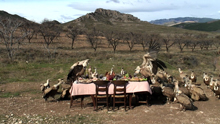Greta Alfaro
Greta Alfaro (Pamplona, 1977) is a visual artist. Her work employs different media, principally video, photography, installation and collage, and is often site-specific. She has a degree in Fine Arts from the Universidad Politécnica de Valencia and a Master’s in Fine Arts from the Royal College of Art in London.
“I reflect on the contemporary by revising the narrative associated with both tradition and the history of art. I use an imaginary that is apparently remote from our routines and our present, but which, installed in a previous substratum of our knowledge and beliefs, is recognisable and still affects us, and I bring it into dialogue with contemporary circumstances, linking it to reflections that are related with the present-day world.
I am interested in our relation with images: on the one hand, the importance of the spectacle in contemporary culture and the consumption that supplants reality, and, on the other, the contrast between the portrait of society that we produce using these images and the reality itself.
I work with the perpetual struggle between the individual, nature and society, between order and chaos; with the contrasts that exist between the ideals proclaimed and imposed by the society in which we live (often imposed by images), and the true identity of the individual, protected in the privacy of the home or in secret (hidden, without images); or between shared values and the reality of nature, alien to them.
Through the meeting of opposites, the juxtaposition of opposing elements, I seek a rereading of each of them, and the generation of a new situation, trying to bring out the unexpected and produce a different logic that is not the logic of everyday events.”
Greta Alfaro
A meticulous staging where everything, down to the smallest detail, seems to be rigorously calculated. It might be an early 20th century office, or perhaps a lavish banquet in the middle of a deserted mountain landscape. A sequence with an unforeseeable ending, an unwinding of events beyond the control of artist and viewers alike. Greta Alfaro’s work indirectly but forcefully relates all the dualisms that inhabit our everyday reality: public and private, colonialism and freedom, chaos and order, natural and artificial, ephemeral and lasting, life and death.
The vultures that invade the banquet of In Ictu Oculi (2009) descend on an idyllic scene, greedily devouring the food and mercilessly demolishing the viewer’s expectations. This is not a random choice; they are scavengers that inevitably remind us of death. This disturbing sequence takes us back to the 17th-century vanitas, but instead of being painted on canvas it is shown on a screen, reminding us with painfully efficiency of the fleetingness of life and the impossibility of avoiding imminent deterioration—moral, social, physical and psychological. Similarly, in In Praise of the Beast (2009) it is wild pigs that appear in a lonely night-time setting to gobble up a huge cake after the appropriate ritual of circling and inspection. Their initial suspicion gives way to a grotesque feast, at which nature demonstrates its supremacy over social rules and impositions.
In this kind of diptych, the behaviour of beasts is unpredictable, just like the chaos that looms over our lives despite our constant struggle to impose unattainable order. Greta Alfaro places the camera at a discreet distance and hides. Patient waiting is rewarded with the natural beauty of a violent act, leaving to one side the rules of etiquette and being aware that group festivities around a table can often conceal other purposes than mere celebration.
While In Ictu Oculi and In Praise of the Beast feature vultures and wild pigs, in A Very Crafty and Tricky Contrivance (2012), it is rats that inhabit an office of the ground floor of the Fish and Coal building in London. The artist attaches her camera to the body of a rat, which then scurries around, hides among papers, reappears and gradually approaches the workers who, unfazed, continue with their alienating bureaucratic tasks. The atmosphere takes us back to the early 20th century. We see a society that ignores its fears and impoverishment, sweeps decay under the carpet and looks the other way to avoid seeing what it doesn’t want to. Time may have passed, but perhaps we haven’t changed that much. The present-day decline of industrial civilization and the demise of capitalism are set in an extremely hierarchical society where each actor has their own role, and most of the characters are just extras whose part is to pretend that the inevitable catastrophe is not happening, lamenting only when no one is watching.
European Dark Room (2010) is also set in an office. A deserted office, stripped of its usefulness by being completely coated in an unidentified substance. The camera does not move; it is the space that mutates. The substance melts, just as time degrades objects. The 400 kilogrammes of chocolate that Alfaro used to coat the office in European Dark Room are a subtle allusion to colonialism, placing the work in a world—that of the office—where hierarchies restrict freedom and bureaucracy does not always facilitate progress.
Marla Jacarilla (visual artist and writer)





